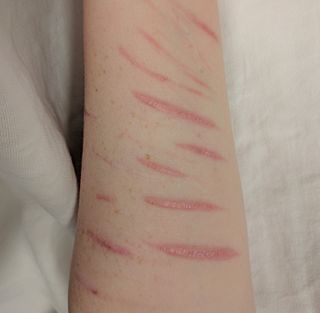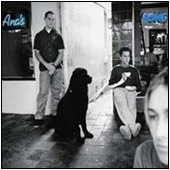Related Research Articles
An eating disorder is a mental disorder defined by abnormal eating behaviors that negatively affect a person's physical or mental health. Types of eating disorders include binge eating disorder, where the patient eats a large amount in a short period of time; anorexia nervosa, where the person has an intense fear of gaining weight and restricts food or overexercises to manage this fear; bulimia nervosa, where individuals eat a large quantity (binging) then try to rid themselves of the food (purging); pica, where the patient eats non-food items; rumination syndrome, where the patient regurgitates undigested or minimally digested food; avoidant/restrictive food intake disorder (ARFID), where people have a reduced or selective food intake due to some psychological reasons; and a group of other specified feeding or eating disorders. Anxiety disorders, depression and substance abuse are common among people with eating disorders. These disorders do not include obesity. People often experience comorbidity between an eating disorder and OCD. It is estimated 20-60% of patients with an ED have a history of OCD.

Self-harm is intentional behavior that is considered harmful to oneself. This is most commonly regarded as direct injury of one's own skin tissues usually without a suicidal intention. Other terms such as cutting, self-injury, and self-mutilation have been used for any self-harming behavior regardless of suicidal intent. The most common form of self-harm is using a sharp object to cut the skin. Other forms include scratching, hitting, or burning body parts. While earlier usage included interfering with wound healing, excessive skin-picking, hair-pulling, and the ingestion of toxins, current usage distinguishes these behaviors from self-harm. Likewise, tissue damage from drug abuse or eating disorders is not considered self-harm because it is ordinarily an unintended side-effect but context may be needed as intent for such acts varies.

Bulimia nervosa, also known as simply bulimia, is an eating disorder characterized by binge eating followed by purging or fasting, and excessive concern with body shape and weight. The aim of this activity is to expel the body of calories eaten from the binging phase of the process. Binge eating refers to eating a large amount of food in a short amount of time. Purging refers to the attempts to get rid of the food consumed. This may be done by vomiting or taking laxatives.
Orthorexia nervosa (ON) is a proposed eating disorder characterized by an excessive preoccupation with eating healthy food. The term was introduced in 1997 by American physician Steven Bratman, M.D. He suggested that some people's dietary restrictions intended to promote health may paradoxically lead to unhealthy consequences, such as social isolation; anxiety; loss of ability to eat in a natural, intuitive manner; reduced interest in the full range of other healthy human activities; and, in rare cases, severe malnutrition or even death.
Promotion of anorexia is the promotion of behaviors related to the eating disorder anorexia nervosa. It is often referred to simply as pro-ana or ana. The lesser-used term pro-mia refers likewise to bulimia nervosa and is sometimes used interchangeably with pro-ana. Pro-ana groups differ widely in their stances. Most claim that they exist mainly as a non-judgmental environment for anorexics; a place to turn to, to discuss their illness, and to support those who choose to enter recovery. Others deny anorexia nervosa is a mental illness and claim instead that it is a lifestyle choice that should be respected by doctors and family.
Binge eating disorder (BED) is an eating disorder characterized by frequent and recurrent binge eating episodes with associated negative psychological and social problems, but without the compensatory behaviors common to bulimia nervosa, OSFED, or the binge-purge subtype of anorexia nervosa.
Sexual anorexia is a term coined in 1975 by psychologist Nathan Hare to describe a fear of or deep aversion to sexual activity. It is a pathological loss of "appetite" for romantic-sexual interaction, often the result of a fear of intimacy to the point that the person has severe anxiety surrounding sexual activity and emotional aspects. The term largely exists in a colloquial sense and is not presently classified as a disorder in the Diagnostic Statistical Manual.
William Stewart Agras is an American psychiatrist and psychotherapist of British origin, research psychiatrist and Emeritus (Active) Professor of Psychiatry and Behavioral Science at Stanford University. He normally goes by Stewart Agras.

"Ana's Song (Open Fire)" is a song by the Australian alternative rock band Silverchair. It was released in May 1999 as the second single from their third album, Neon Ballroom. The song is about lead vocalist Daniel Johns' struggle with anorexia nervosa. "Ana's Song" peaked at No. 14 on Australia's ARIA Singles Chart, at No. 12 on the US Billboard Modern Rock Tracks chart, and at No. 28 on the Billboard Mainstream Rock Tracks chart. At the ARIA Music Awards of 1999, it was nominated for two awards. The track also earned Silverchair a Comet Award in Germany.
The history of anorexia nervosa begins with descriptions of religious fasting dating from the Hellenistic era and continuing into the medieval period. A number of well known historical figures, including Catherine of Siena and Mary, Queen of Scots are believed to have suffered from the condition.
Wannarexia, or anorexic yearning, is a label applied to someone who claims to have anorexia nervosa, or wishes they did, but does not. These individuals are also called wannarexic, “wanna-be ana” or "anorexic wannabe". The neologism wannarexia is a portmanteau of the latter two terms. It may be used as a pejorative term.

Hilde Bruch was a German-born American psychiatrist and psychoanalyst, known foremost for her work on eating disorders and obesity.

Anorexia mirabilis, also known as holy anorexia or inedia prodigiosa or colloquially as fasting girls, is an eating disorder, similar to that of anorexia nervosa, that was common in, but not restricted to, the Middle Ages in Europe, largely affecting Catholic nuns and religious women. Self-starvation was common among religious women, as a way to imitate the suffering of Jesus in his torments during the Passion, as women were largely restricted to causing themselves voluntary pain by fasting, whereas holy men experienced suffering through physical punishment, voluntary poverty, and celibacy.
Maudsley family therapy also known as family-based treatment or Maudsley approach, is a family therapy for the treatment of anorexia nervosa devised by Christopher Dare and colleagues at the Maudsley Hospital in London. A comparison of family to individual therapy was conducted with eighty anorexia patients. The study showed family therapy to be the more effective approach in patients under 18 and within 3 years of the onset of their illness. Subsequent research confirmed the efficacy of family-based treatment for teens with anorexia nervosa. Family-based treatment has been adapted for bulimia nervosa and showed promising results in a randomized controlled trial comparing it to supportive individual therapy.

Anorexia nervosa, often referred to simply as anorexia, is an eating disorder characterized by low weight, food restriction, body image disturbance, fear of gaining weight, and an overpowering desire to be thin. Anorexia is a term of Greek origin: an- and orexis, translating literally to "a loss of appetite"; the adjective nervosa indicating the functional and non-organic nature of the disorder. Anorexia nervosa was coined by Gull in 1873 but, despite literal translation, the feeling of hunger is frequently present and the pathological control of this instinct is a source of satisfaction for the patients.

Gürze Books, LLC is a Carlsbad, California based publishing company specializing on books addressing eating disorders and body image. It has been an imprint of Turner Publishing Company since 2018.
Body image disturbance (BID) is a common symptom in patients with eating disorders and is characterized by an altered perception of one's own body.

The Best Little Girl in the World is a 1979 American young adult coming of age novel by Steven Levenkron, telling the story of Kessa, a fictional teenager who suffers from an eating disorder. The book was originally published by Warner Books in 1979. It was adapted into a 1981 ABC TV film by the same name, and it won the American Library Association Best Book for Young Adults Award.
References
- ↑ Edwards, Tamala M. (November 9, 1998). "What the Cutters Feel". Time . Archived from the original on February 14, 2008. Retrieved August 24, 2010.
- ↑ "The Luckiest Girl in the World". Penguin Group. Archived from the original on August 28, 2010. Retrieved August 26, 2010.
- ↑ "Levenkron, Steven : The Best Little Girl in the World". New York University . Retrieved August 24, 2010.
- ↑ Becker, Daniel (2005). This Mean Disease: Growing Up in the Shadow of My Mother's Anorexia Nervosa. Gurze Books . Google Books. Retrieved on August 24, 2010.
- ↑ "The BEST LITTLE GIRL IN THE WORLD (1981)". British Film Institute. Archived from the original on February 8, 2009. Retrieved August 24, 2010.
- ↑ Lawson, Carol (March 22, 1985). "DOCTORS CITE EMETIC ABUSE". The New York Times . Retrieved August 24, 2010.
- ↑ Solomon, Michelle (April 10, 2002). "Stars Vulnerable To Anorexia, Expert Says". KIRO-TV . Retrieved August 24, 2010.[ permanent dead link ]
- ↑ "New court papers tell of Phoebe's dark last day". Irish Independent. April 18, 2010. Retrieved August 24, 2010.
- ↑ Mann, Denise (May 3, 2004). "When Scab-Picking, Cutting Becomes Addictive". MedicineNet . Retrieved August 25, 2010.
- ↑ "Painful Secrets (US Version)". YesAsia . Retrieved August 25, 2010.
- ↑ "Anorexia | Bulimia | Anorexia Nervosa | OCD | Psychotherapist Steven Levenkron".